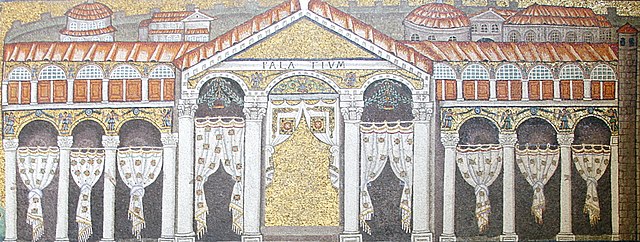The Ostrogothic Kingdom, officially the Kingdom of Italy, existed under the control of the Germanic Ostrogoths in Italy and neighbouring areas from 493 to 553.
Ostrogothic Kingdom
Epigraph originally placed at the Pavia amphitheater in which the restorations carried out between 528 and 529 by Athalaric at the amphitheater are mentioned, Pavia Civic Museums.
The Palace of Theodoric, as depicted on the walls of St. Apollinare Nuovo. The figures between the columns, representing Theodoric and his court, were removed after the East Roman conquest.
The Ostrogoths were a Roman-era Germanic people. In the 5th century, they followed the Visigoths in creating one of the two great Gothic kingdoms within the Western Roman Empire, drawing upon the large Gothic populations who had settled in the Balkans in the 4th century. While the Visigoths had formed under the leadership of Alaric I, the new Ostrogothic political entity which came to rule Italy was formed in the Balkans under Theodoric the Great.
The Mausoleum of Theodoric in Ravenna, Italy
Ostrogothic bow-fibulae (c. 500) from Emilia-Romagna, Italy
The Concesti helmet was found among the burial goods of a probable Ostrogothic Prince. Hermitage Museum.
Ostrogothic belt buckle, Pavia Civic Museums







